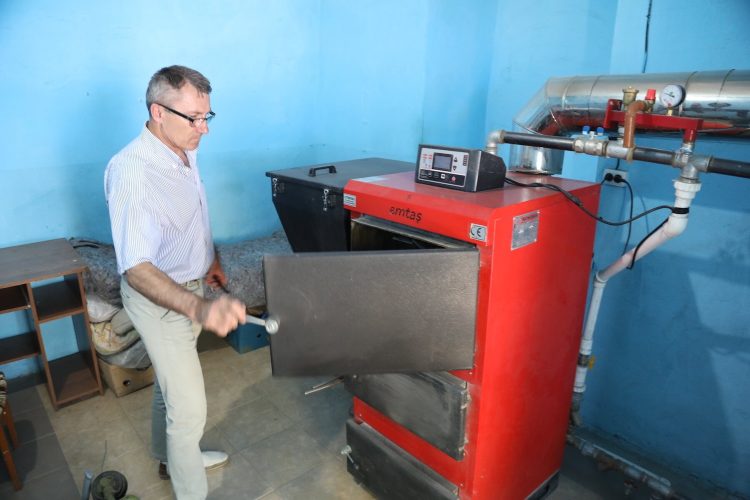TriplePundit • How One Country’s Russian Gas Crisis Became a Green Energy Boom

This story originally appeared in Reasons to be Cheerful.
The village of Volintiri is about as remote as you can get in Europe. Set in the rural southeast of Moldova, one of the poorest and least visited countries on the continent, it is only a couple of miles away from a little-used border with Ukraine.
Yet Volintiri, which is surrounded by a countryside filled with fields of wheat, corn and sunflowers, is in some ways perhaps superior to the great capitals of Europe such as Berlin, Paris, Rome and Madrid.
This community of about 2,500 people is leading the way for Moldova when it comes to the movement for reliable, locally produced, independent energy. At a time of increasing global conflict, it aspires to be a place where the supply of power does not depend on anything from outside, and stands as proof that community-based renewable energy systems can help cut emissions and bills, while engaging citizens in the urgent green energy transition.
“We want to be prepared for a global crisis,” says Igor Hîncu, mayor of Volintiri since 2019, sitting in his homey office at the center of town.
Modest but impactful steps have been taken over the past few years. Solar panels have been installed on the roofs of the kindergarten and the customs office, as well as a dozen private homes. Soon more will be put up, this time on the roof of the hospital.
Meanwhile, biomass heating systems, powered by sustainable fuel sources, are now being used instead of gas at the kindergarten, the town hall and the local Entrepreneurship Support Center.
And simple steps have been taken to improve energy efficiency, such as the deployment of energy-efficient lightbulbs and the installation of insulation within the walls of the town hall.
“It’s already ensuring us a partial energy independence,” says Hîncu.
For many years, Moldova sourced 100 percent of its energy in one way or another from Russia — it received all its gas directly from Russia, and its electricity came from a power plant located in Moldova’s breakaway region Transnistria, itself entirely powered by Russian gas.
But since the full-scale war on Ukraine broke out in 2022, Moldova has faced huge challenges when it comes to its energy supply, with Russian fossil fuels no longer viable. Energy prices in the country have skyrocketed and some areas have even suffered blackouts.
“When the war started we felt very vulnerable,” says Hîncu. “Prices for energy went up a lot.”
To heat Volintiri’s kindergarten in winter 2021 cost about 5,000 Moldovan lei ($296) per month, according to Hîncu. By winter 2023, it cost more than 48,000 lei ($2,850) per month.
“We stopped using gas, we had to, and we switched to biomass,” he says.
With the help of the Moldovan environmental nonprofit Ecovisio, Volintiri installed a biomass heater in the kindergarten and sourced fuel in the form of biomass pellets made of wood and sunflowers from a neighboring region.
The kindergarten’s heating bills immediately halved.
Its electric bills have dropped too: Before, they were around 5,000 to 6,000 lei ($296-$356) a month. But the solar panels have already cut that by 2,000 lei — more than a third of the bill.
In June, Volintiri’s solar output reached a new monthly high of 1500KW, the equivalent of powering several homes.
“Green energy is in my DNA, my blood,” says Hîncu. “As a mayor I want to leave something good behind.”
Volintiri’s early success is part of the wider transformation of Moldova’s energy supply towards local renewables, namely solar and wind power.
This incredible shift has taken place with impressive speed. In 2021, just 3 percent of Moldova’s energy came from renewables, according to Constantin Borosan, the secretary of state for Moldova’s Ministry of Environment. Four years later, the average is now up to 25 percent — and that can reach something like 40 percent on particularly sunny and windy days.
“We have made more progress in two to three years than many countries have in a decade,” says Borosan. “The energy crisis served as an impulse. Renewables are contributing to our energy security.”
Now, Moldova is looking to build on those advances by encouraging energy systems run and owned by citizens.
In 2024, the government passed a regulation giving the green light to “Communities for Energy from Renewable Sources,” allowing cooperatives to be set up and to link their local renewable energy sources like solar panels to the grid. Volintiri is one of several pilot municipalities in Moldova, along with Nisporeni, Tomai, Filipeni, Zubresti, Putintei, Straseni and Mindresti.
Proponents in Moldova say that energy communities are a way of keeping bills down, reducing carbon emissions and creating a more resilient supply of power.
“Community-led renewable energy cooperatives in Moldova are a pioneering model for the region,” said Mircea Dragomir, project officer at the United Nations Development Programme (UNDP) Moldova, in an emailed statement. “These Energy Communities empower citizens, local public authorities and civil society organizations to generate, manage and share clean energy, primarily solar, at the local level.”
The UNDP is currently working with three Moldovan nonprofits to scale up energy communities across the country. “These communities are not only about energy, they’re about local resilience, democratic participation and economic inclusion,” added Dragomir.
Moldova’s initiative echoes a similar one in the European Union. In 2022, the REPowerEU Plan proposed that member states adopt the political objective of creating one energy community per municipality with a population of more than 10,000. “Energy communities can be an effective means of re-structuring our energy systems, by empowering citizens to drive the energy transition locally and directly benefit from better energy efficiency, lower bills, reduced energy poverty and more local green job opportunities,” the plans say.
Long-standing projects such as France’s Enercoop and Germany’s EWS have shown the proven benefits of community-led approaches, securing hundreds of thousands of members and customers to the renewable energy networks.
Birgitte Bak-Jensen, a professor at the Department of Energy Technology at Aalborg University in Denmark, notes that these energy communities are an effective way of supporting the green transition since they overtly involve locals as beneficiaries.
“People who are running their local energy communities, they engage, they gain much more knowledge. They have a kind of ownership,” she says.
Depending on the context, local energy communities also can play diverse roles, adds Bak-Jensen.
“For instance, with projects in India, they might help bring the first electricity source to a community at all,” she explains. “But in the Netherlands, where there are issues with capacity, if you have your own supply, you can lessen the demand on the grid.”
But Bak-Jensen warns that, despite the popularity of energy communities, some face significant challenges due to bureaucracy and regulatory barriers.
“If you want to set up a local community in Denmark, you must set up your own organization as an energy supplier,” she says. “It’s complicated. It can be very troublesome for communities who want to establish an organization. Laymen can’t be in charge of this.”
Nonetheless, in places like Volintiri there is clearly demand for community-owned, independent power, given the benefits it has already shown.
Valentina, a 60-year-old social worker buying goods at the local store, says that she was keen for the community to ramp up the initiative. Currently, she spends as much as a third of her salary on bills. “Everything is expensive,” she says.
The town also hopes that those savings can bring wider changes. For one, some savings are already being used to invest in the school’s sports facilities.
But there is also the broader idea that better living conditions will counteract the depopulation that many rural areas across Moldova, and indeed the world, are facing.
“We have good internet and cheap energy,” says Hîncu’s wife, Ina, beside him in the town hall. “Maybe people will come back. It’s a great opportunity.”



Post Comment